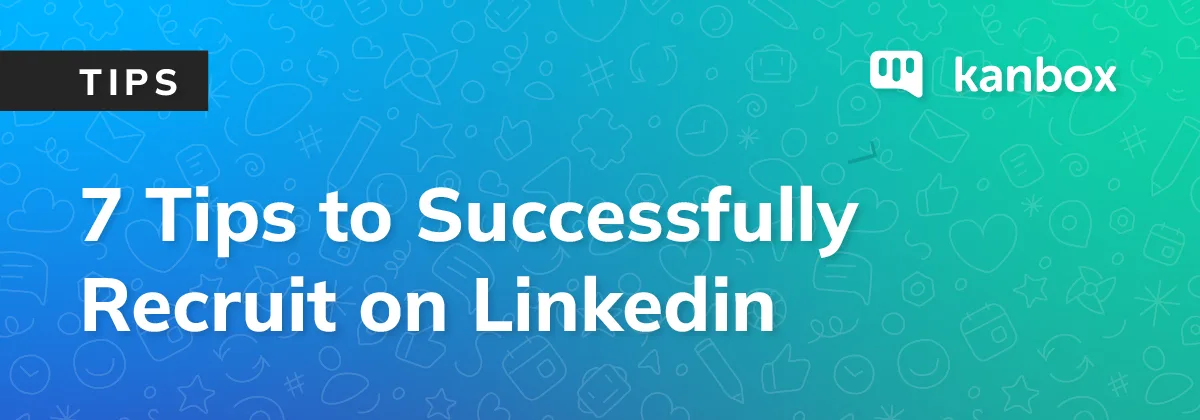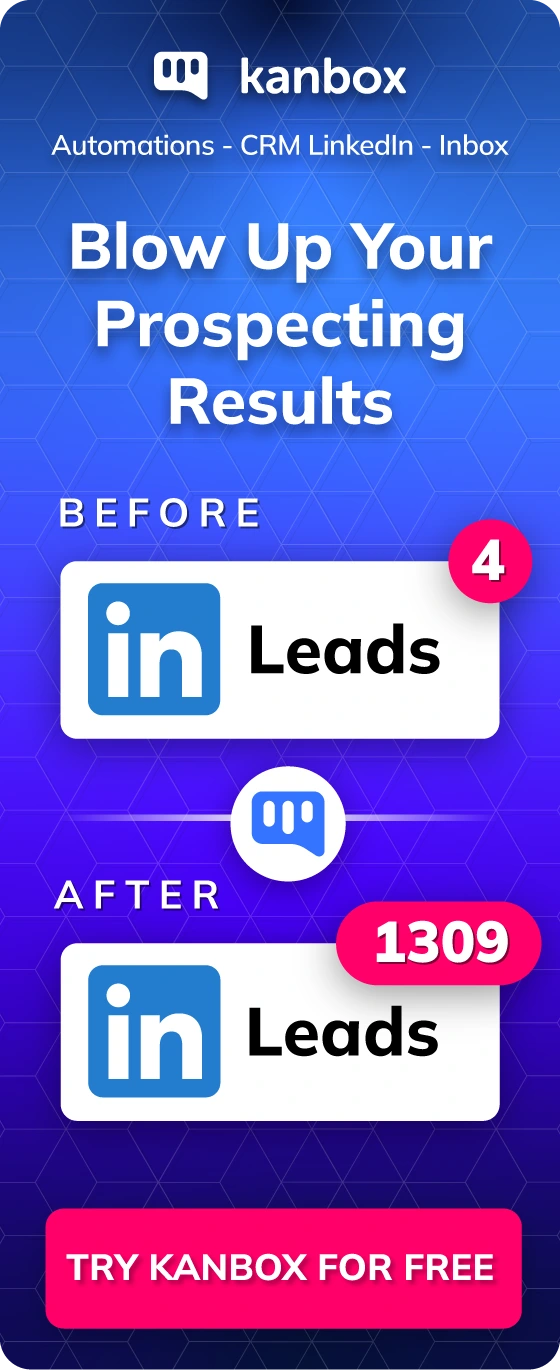7 Tips to Successfully Recruit on Linkedin and Find Top Talent
As a savvy recruiter, you're well aware that Linkedin is a valuable pool of potential candidates. With tens of millions of active users worldwide, this social platform provides a vast talent pool at your fingertips.
The LinkedIn recruitment market
Here are some key statistics and recent trends related to prospecting and recruitment on LinkedIn.
- LinkedIn had over 950 million users worldwide.
- According to a study, 87% of recruiters use LinkedIn to search for candidates.
- Approximately 70% of talents on LinkedIn are not actively seeking employment but may be open to new opportunities.
- LinkedIn users actively engage with job listings, with over 20 million job posts every week.
- Nearly 60% of LinkedIn users access the platform via mobile devices, highlighting the importance of mobile recruitment.
- Companies with a strong presence on LinkedIn see a 50% increase in employee engagement and a 28% reduction in turnover.
- The LinkedIn Recruiter tool, specifically designed for recruitment, is used by thousands of companies worldwide.
- Companies that regularly share content on their LinkedIn page experience increased visibility, with a 14 times higher engagement rate.
Recruitment on LinkedIn vs traditional platforms: Pros and cons
Recruitment on LinkedIn
Pros
- Extensive professional network with detailed profiles.
- Ability to target specific candidates based on professional criteria.
- Direct engagement with candidates through messaging and professional interactions.
Cons
- Potentially higher cost compared to some traditional platforms when using the Premium service.
- Dependency on candidates' LinkedIn connectivity.
Traditional recruitment platforms
Pros
- Diverse candidate database.
- Accessibility to a wide range of professional sectors.
- Variable costs depending on subscription options.
Cons
- Profiles often less detailed than on LinkedIn.
- Less direct interaction with candidates.
Succeeding in recruitment on LinkedIn involves more than creating a profile and posting job listings. To optimize your approach and discover profiles that perfectly match your needs, we offer 7 essential tips.
Create an attractive Linkedin company page
When aiming for successful Linkedin recruitment, the critical first step is to create and optimize your company page. This page is essential and serves as a showcase for potential candidates. Think of it as the first impression you make on professionals who visit your page.
It's crucial that this initial impression is positive and engaging.
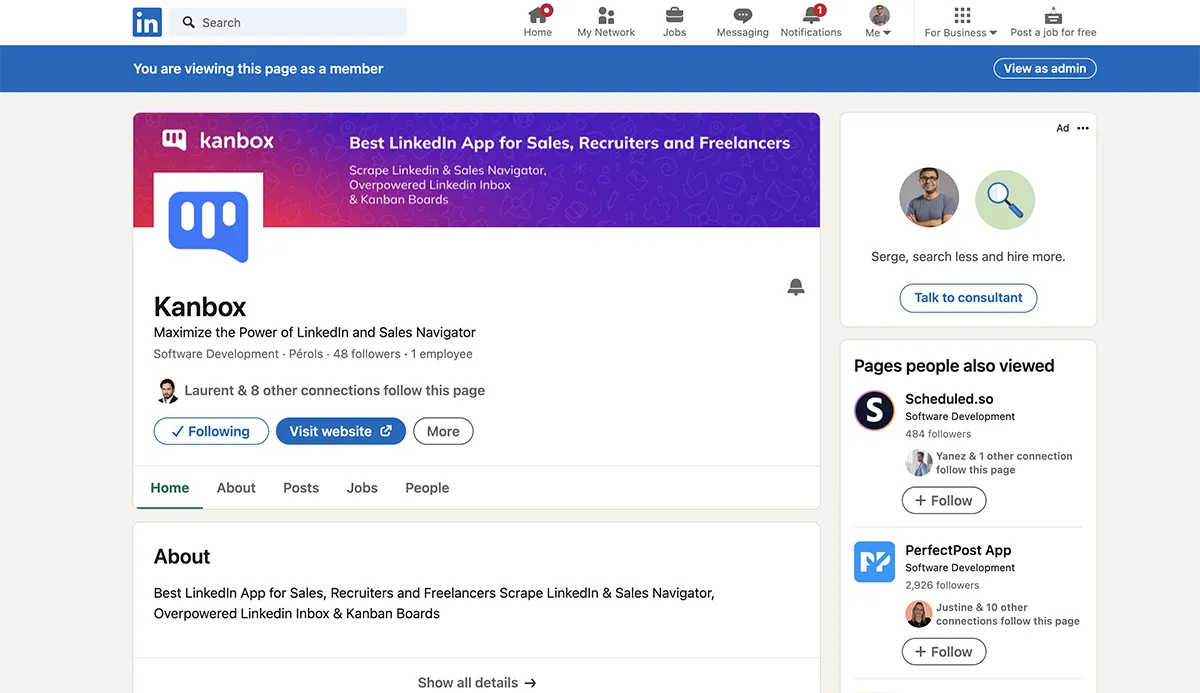
Start by ensuring your profile image is professional. Use a clear, high-quality image that represents your company well. This is often the first thing users see, so it's essential to present a welcoming face.
Next, use a compelling cover image. Rather than using a generic image, choose one that reflects your company's essence.
For example, if you're a technology-focused company, an image of your team working on an exciting project can be an excellent choice.

As for your company description, this is where you have the opportunity to tell your story. Provide a concise yet inspiring description of your company, highlighting your culture, values, and vision. Showcase concrete examples of significant projects or initiatives that embody these values. By showing instead of just telling, you create a powerful narrative that can attract like-minded candidates.
Exemple of attractive Linkedin company page introduction
ABC Innovations is a leading company in the clean technology industry, dedicated to pushing the boundaries of ecological innovation.
Our diverse team of passionate professionals shares a common vision: to create a positive impact on the environment while tackling stimulating challenges.
🌍 Mission: At ABC Innovations, we are committed to developing sustainable solutions that shape a better future for our planet. Each member of our team actively contributes to this mission by bringing their unique expertise and passion.
🚀 Why Join ABC Innovations?
. Innovative projects serving the environment.
. Company culture focused on collaboration and personal development.
. Opportunities for professional growth and leadership.
. Join us in this exciting adventure where every day is an opportunity to contribute to a more sustainable world.
To avoid:
XYZ Construction Works is a construction company.
We need people to work in our construction company. If you like working outdoors, send us a CV.
Guaranteed minimum wage. 🏗️
Developing your employer brand
Developing your employer brand is a key aspect of attracting top talent. This means showing potential candidates why your company is the place they want to work. To do this, create and share authentic content that highlights what makes your company special.
Share employee testimonial
Employee testimonials are an excellent way to do this. Candidates want to know the experiences of those who have already chosen to work for your company.

You can publish videos or articles where your employees share their experiences, accomplishments, and passion for their work. This allows candidates to see themselves in the role and feel what it's like to work for your company.
Highlight your company culture
In addition to testimonials, showcase the work environment.

If you have a beautiful office, cool relaxation areas, or social initiatives, share them with images or videos.

For example, if your company hosts regular team events, showcase these moments of camaraderie to give candidates a glimpse of your company's culture.

When candidates see these aspects of your company, they are more likely to be attracted to the prospect of working with you.
Leveraging Linkedin groups for recruitment success
Linkedin, as the leading professional network, offers a wealth of opportunities for recruiters to find top talent.
One effective strategy is to join relevant Linkedin groups. These groups provide a platform where professionals with similar interests and expertise come together to network, share insights, and explore job opportunities.
Here's how you can make the most of this valuable resource for your recruitment efforts:
Identify and join relevant LinkdIn groups
First and foremost, pinpoint and join LinkedIn groups aligned with your industry or niche to tap into a community of professionals discussing trends, industry news, and potential job opportunities.
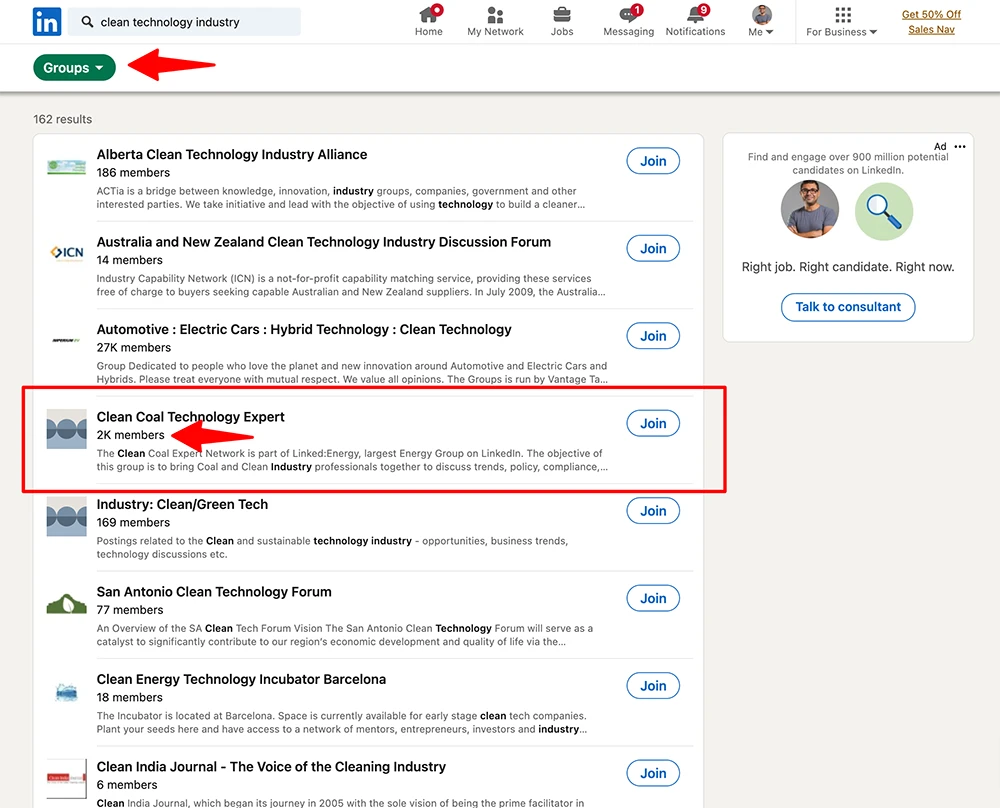
Utilize specific keywords in your search to align with your recruitment needs.
Joining regional groups can streamline recruitment efforts, and considering the group's member count is vital for maximizing your outreach.
Engage actively
Once you're a member of relevant groups, don't just lurk in the shadows.
Actively participate in group discussions and engage with members. By sharing your insights and knowledge, you can establish yourself as a knowledgeable and trusted recruiter within the group.
The more you participate, the more visibility and credibility you'll gain.
Observe group rules
It's important to respect the rules and guidelines of each Linkedin group.
Some groups may allow job postings in their feeds, while others may not. Always adhere to the specific posting policies of the groups you join. Posting jobs where it's allowed can be an effective way to connect with potential candidates.
Share job openings
When it's permitted by the group, share your job openings in the feeds.
Craft engaging job posts that provide essential information about the role, your company, and the application process. Encourage interested candidates to reach out or apply directly.
Build relationships
In addition to posting jobs, focus on building relationships with potential candidates. If someone expresses interest in a job post or comments on a discussion you've contributed to, take the opportunity to connect with them personally.
Optimizing job postings
When creating job postings on LinkedIn, clarity is essential to help potential candidates quickly understand the position and assess its suitability for their skills and goals.
It's crucial to structure the listing effectively by starting with a captivating introduction about the company and the role, followed by a detailed description of responsibilities.
Specify required qualifications, including skills and experience, to attract suitable candidates.
Conclude by highlighting the company's benefits to attract candidates who align not only in skills but also in values and aspirations.
Exemple
🚀 Exciting Opportunity at ABC Innovations - Full-Stack Developer Wanted!
Are you a passionate Full-Stack Developer looking to make a meaningful impact through your work? ABC Innovations, a leading clean technology company, is expanding its team and is on the lookout for a talented individual to join us on our mission to create innovative, eco-friendly solutions.
Role: Full-Stack Developer
Location: [City], [Country]
Responsibilities:
. Collaborate with cross-functional teams to design and implement high-quality software solutions.
. Develop and maintain scalable web applications.
. Participate in code reviews and knowledge-sharing sessions.
. Stay updated on industry trends and incorporate best practices into our projects.
Requirements:
. Proven experience as a Full-Stack Developer.
. Proficiency in front-end and back-end technologies.
. Strong problem-solving skills and attention to detail.
. Passion for sustainable technology solutions.
What We Offer:
. Exciting projects at the forefront of environmental innovation.
. Collaborative and dynamic work environment.
. Opportunities for professional growth and skill development.
If you're ready to contribute to a greener future through technology, apply now! Send your resume and portfolio to [Email Address].
To avoid:
XYZ Construction Works Hiring Now!!!
Developer wanted. Must know code. We have projects. Apply if you want.
Pay is okay.
Email your stuff to [Email Address]
Should I indicate the salary in my job postings?
Cultural considerations in salary Ttansparency for job postings
The decision to disclose or withhold salary information in job postings is influenced by cultural norms and recruitment practices prevalent in different countries.
Transparency regarding salary is often valued in cultures that prioritize fairness and trust within the workplace, such as in Nordic countries.
Conversely, in cultures where salary discussions are perceived as private, companies may be more reluctant to provide upfront salary details.
Negotiating salary is a standard practice in some cultures, and employers may refrain from disclosing initial salary information to maintain flexibility during negotiations.
Additionally, legal and market norms regarding salary disclosure vary across regions. It is crucial for companies to tailor their recruitment practices to the specific cultural context of the country in which they operate to effectively attract and retain top talent.
Indicating the salary upfront can:
-
Salary transparency can attract candidates whose salary expectations align with the offer, reducing the number of unqualified applications.
-
By providing this information upfront, candidates can quickly assess their interest, potentially saving time for both parties.
-
Open communication about salary can help build trust between the employer and candidates, enhancing transparency in the recruitment process.
-
Salary transparency may reduce the need for prolonged negotiations, potentially expediting the recruitment process.

Active engagement with candidates
When candidates show interest in a position, maintaining active engagement is essential. Open and transparent communication is key to creating a positive experience. Respond promptly to their questions and concerns. Ensure they receive clear information about the recruitment process. If you take too long to respond, candidates may lose interest and pursue other opportunities.
Use recruitment management tools
Using an Applicant Tracking System (ATS) is a strategic step to streamline the recruitment process. ATS systems are designed to help recruitment teams efficiently sort, store, and manage applications. They offer features such as interview scheduling, internal feedback sharing, and creating a complete history of interactions with candidates. This simplifies recruitment process organization.
The more affordable LinkedIn Recruiter Lite subscription, which is the most widely sold, does not come with a dedicated ATS solution, unlike LinkedIn Recruiter and LinkedIn Recruiter Professional Services.
You will need to turn to third-party ATS tools such as Flatchr, Beetween, WeRecruit, and SmartRecruiters.
Measurement and adaptation
Performance measurement is a fundamental step in improving your recruitment strategy.
Linkedin analytics tools allow you to track various metrics to assess the effectiveness of your recruitment efforts. One key metric to monitor is the time it takes to fill a position. If this duration is unusually long, it may indicate obstacles in the recruitment process that need to be identified and resolved.
The success rate of your listings is also an important indicator. If your listings attract few qualified candidates, it may be a sign that you need to revise the content to make it more appealing. Carefully examine the types of candidates you are attracting to ensure they align with your needs.
Don't forget to measure the number of engaged candidates. If you've managed to attract good candidates but they drop out along the way, it may indicate an issue in the recruitment process or in candidate communication. Ensure that you maintain a high engagement rate throughout the process.
Using Linkedin Premium Recruiter
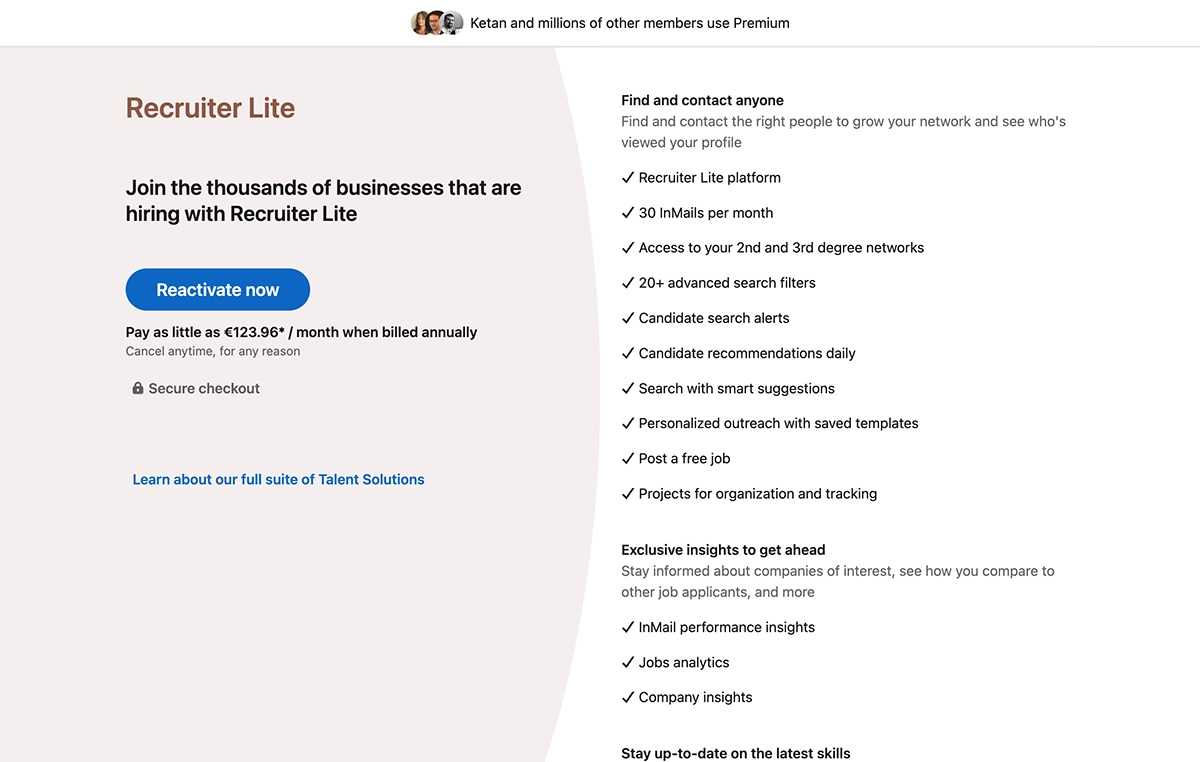
LinkedIn Recruiter Lite is the entry-level version of LinkedIn's recruitment tool, well-suited for individuals and small teams working in small to medium-sized enterprises with limited recruitment needs. Recruiter Lite can be subscribed to online with a monthly or annual subscription, providing the flexibility to cancel at any time. New users may also enjoy a 30-day free trial upon their initial sign-up.
LinkedIn Recruiter is the most powerful recruitment solution on the platform, well-suited for teams in medium to large-sized enterprises.
LinkedIn Recruiter Professional Services (RPS) stands out as the optimal solution for recruitment agencies.
To help you make an informed decision regarding different Linkedin Premium subscriptions, we have published a detailed comparison, allowing you to choose the subscription that best aligns with your recruitment goals.
Linkedin Premium Recruiter Lite vs Sales Navigator Core
If you're considering upgrading to a paid version of Linkedin, it's important to compare the available subscription to find the one that best suits your specific recruitment needs. Two common choices are Linkedin Premium Recruiter Lite and Sales Navigator Core.
Sales Navigator Core is primarily designed for sales professionals, but it proves to be an invaluable asset for recruitment. Its extensive search function allows you to find potential candidates beyond your current network.
Unlike Premium Recruiter Lite, which is limited to searching among members actively seeking employment, Sales Navigator explores all Linkedin members. In other words, if your goal is to recruit the best talent, whether currently employed or not, investing in a Sales Navigator license is highly recommended.
To achieve the same scope as Sales Navigator, you will need to switch to the more expensive offerings: Premium Recruiter or LinkedIn Recruiter Professional Services.
In my opinion, Sales Navigator Core will be much more powerful for finding talent across a broader range than just job seekers, but by choosing it, you won't have access to the overall stats of your recruitment campaigns and a free job posting.
Kanbox, a powerful and highly cost-effective platform for recruiting on LinkedIn
Kanbox is a platform that simplifies communication and management of your LinkedIn network and candidates, automates repetitive tasks in your recruitment processes, and centralizes your LinkedIn interactions.
Kanbox is also designed for recruiting teams.
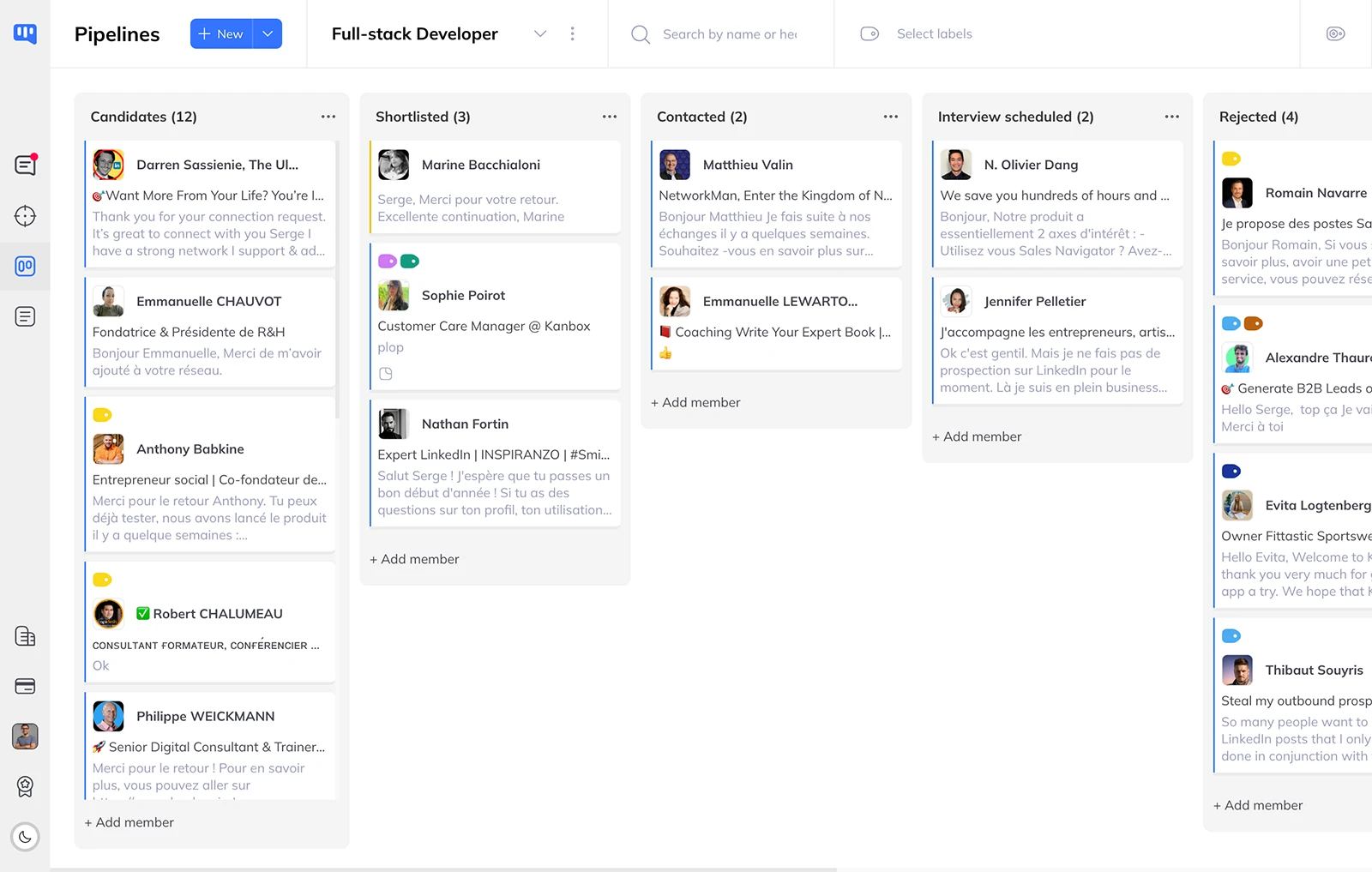
Key Recruitment Features of Kanbox
Kanbox provides 7 key functionalities to enhance the entire recruitment process:
- Communicate and manage your network throught Kanbox smart inbox.
- Full-screen chat with candidate key information and notes.
- Export candidates from Linkedin and Sales Navigator into Kanbox.
- Use recruitment pipelines to manage your recruiting process.
- Craft customized message templates to eliminate repetitive copy-and-paste message from a candidate to another.
- Send bulk connection requests and messages.
Kanbox to communicate and manage your LinkedIn network
Explore a more efficient way to manage your LinkedIn inbox and network.
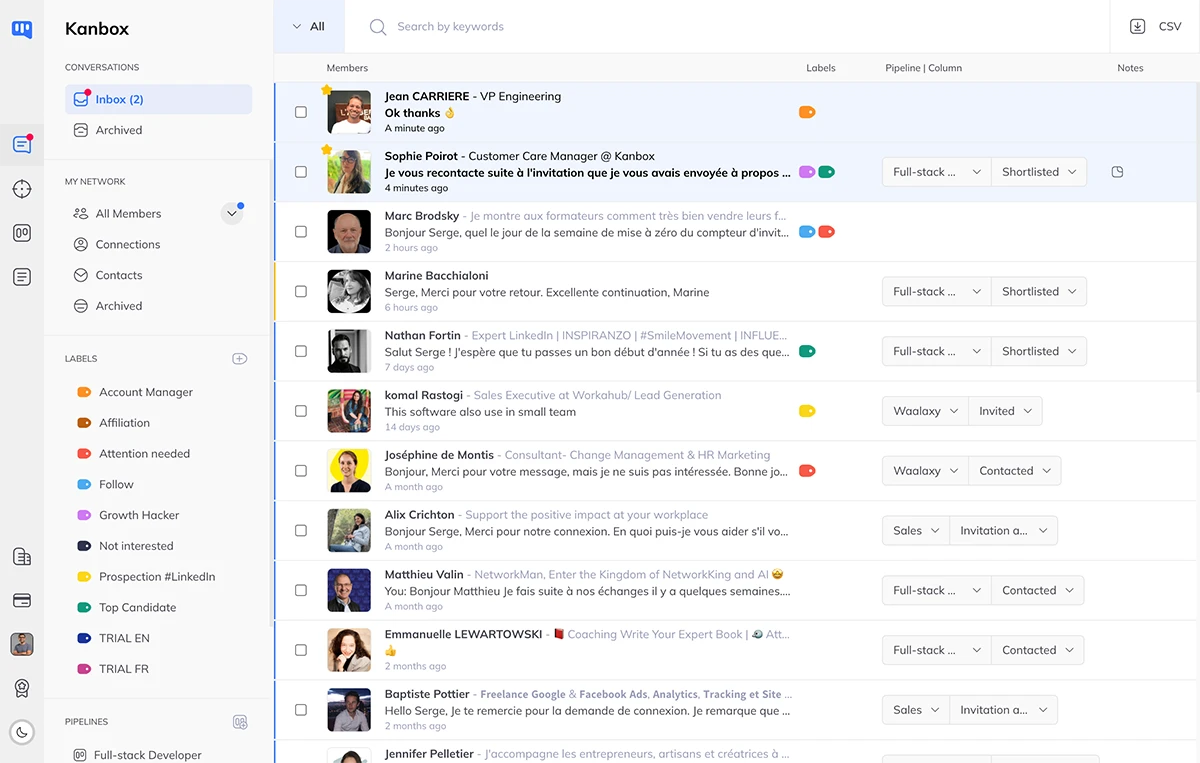
Organize your conversations like an email Inbox
Handle your conversations in Kanbox similarly to managing emails. Read, sort, and archive your conversations effortlessly.
Never miss a message
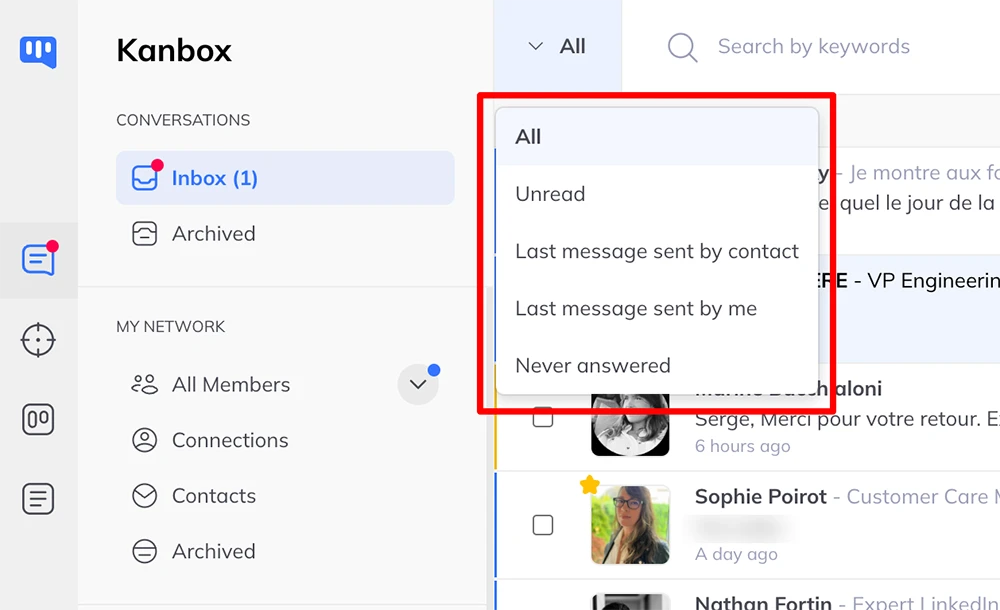
Use filters to ensure no message is overlooked :
- All
- Unread
- Last message sent by contact
- Last message sent by me
- Never answered
Filters to quickly access important conversations
Effortlessly filter through your connections and contacts, and with labels, easily identify members and conversations that require your attention.
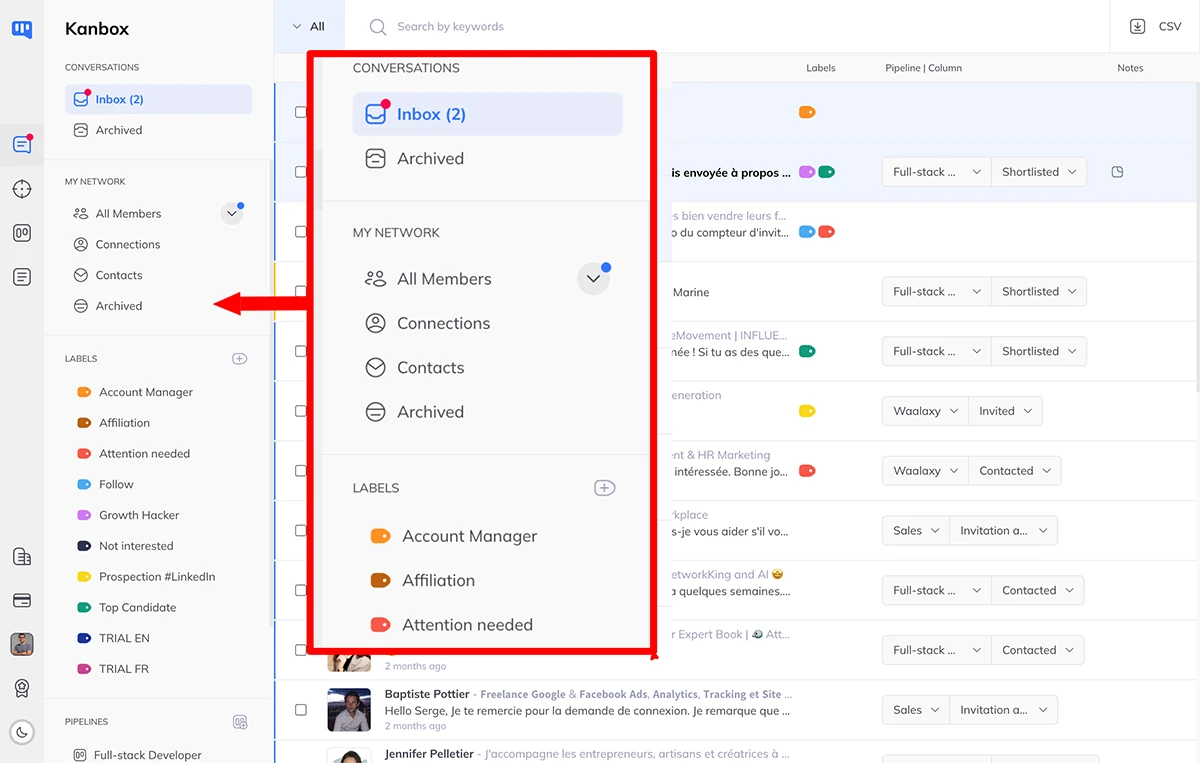
Streamlining candidate management with labels
Streamline lead management in Kanbox by creating and managing labels effortlessly. These labels not only simplify lead categorization but also help visualize ongoing processes, keeping you proactive in prospect management.
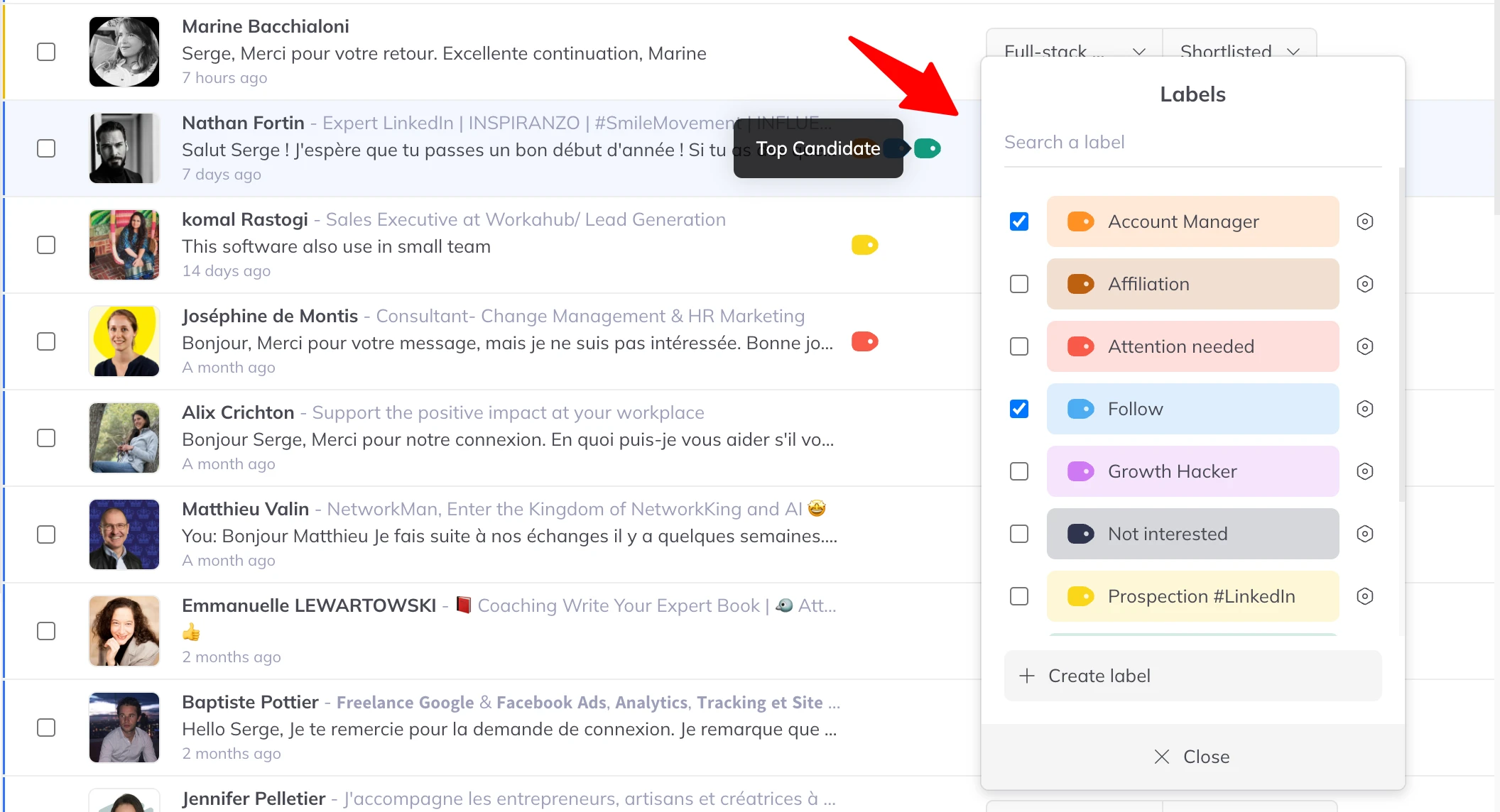
Streamline operations: efficient bulk actions
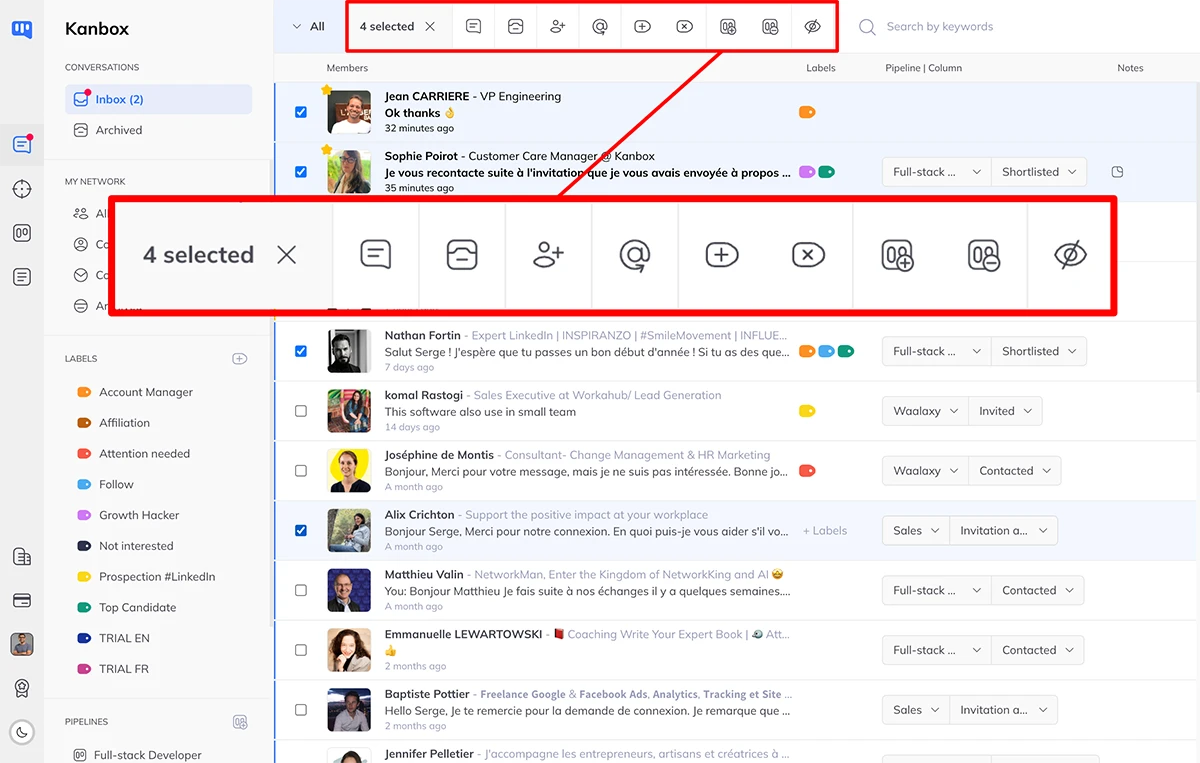
Save considerable time by performing bulk actions such as sending messages or connection requests, archiving, and applying labels to multiple candidates at once in Kanbox:
- Send message
- Archive Messages
- Send Connection requests
- Find Missing Email Addresses
- Add / Remove labels
- Add / Remove pipelines
- Hide Members
An intuitive full-screen chat with key information about members at your fingertips
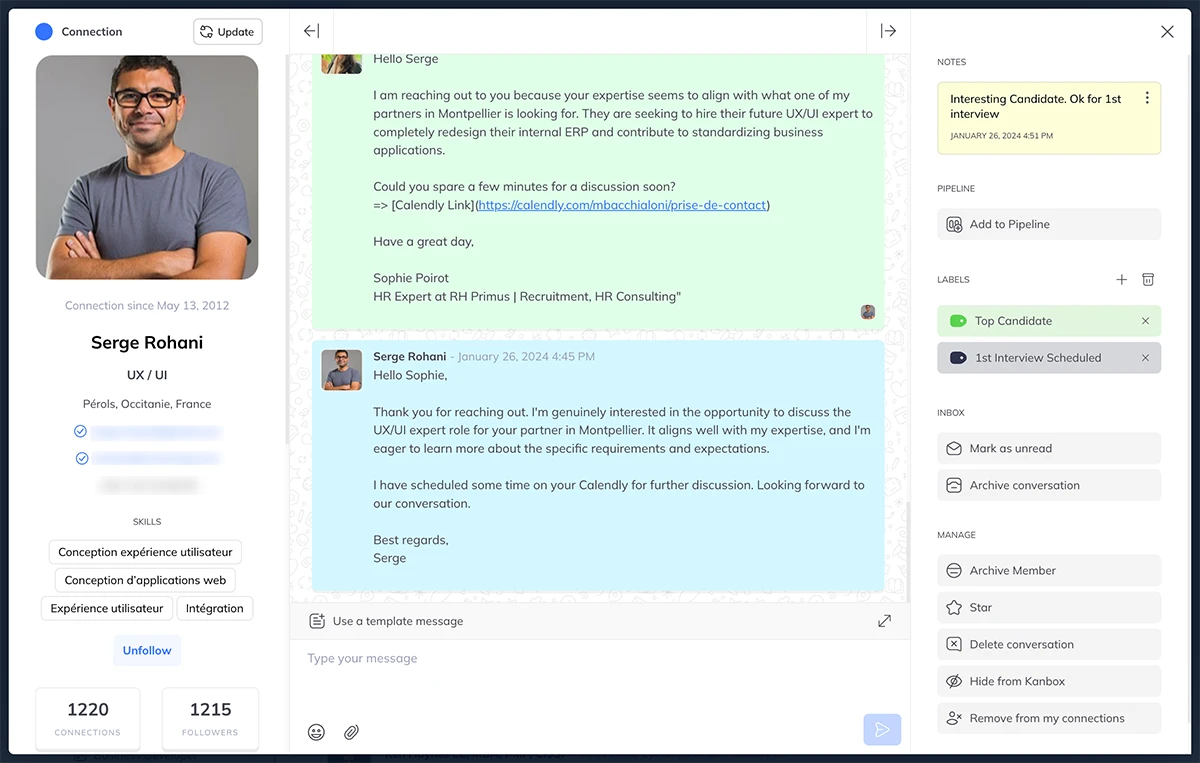
Kanbox's chat brings together all candidate information, conversations, and necessary actions for tracking and building a quality relationship.
On the left, candidate information:
- Profile picture
- Headline
- Job title
- Contact information
- Location
- Skills
- Company
- Experience
- ...
In the middle, the messages and the message input field.
On the right :
- Note
- Pipeline
- Labels
- Inbox actions
- Management actions
Kanbox Pipelines for Recruitment

Kanbox incorporates Kanban Pipelines for recruitment, allowing you to visualize every stage of your recruitment processes and significantly enhance your efforts.
No more repetitive tasks!
Kanbox Kanban Pipelines enable increased speed and improved organization.
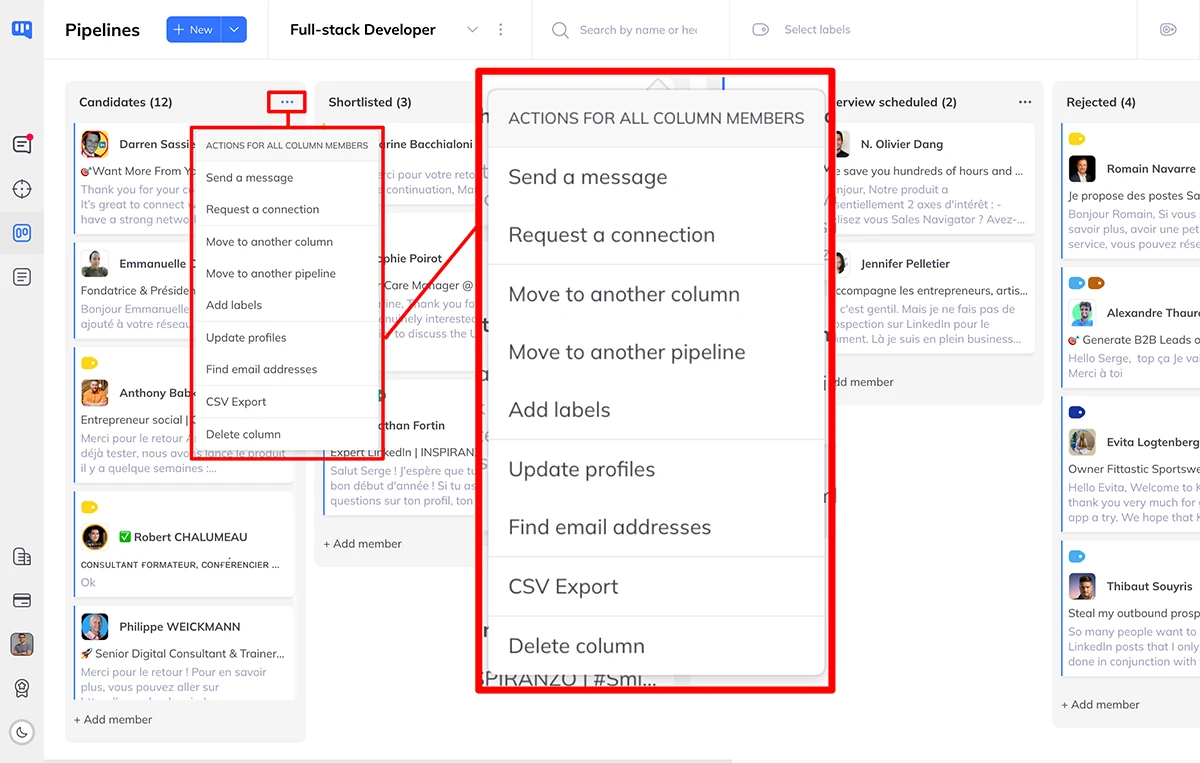
Various actions are at your disposal in each column to eliminate the tedium of repetitive tasks and save a substantial amount of time:
- Send Message
- Request connection
- Move to other columns
- Move to another pipeline
- Add labels
- Update profiles
- Find missing email addresses
- Export to CSV
- Delete column
Craft customized message templates to eliminate repetitive copy paste
Kanbox simplify your messaging process through its message templates, enabling you to create personalized and impactful messages for different candidates.
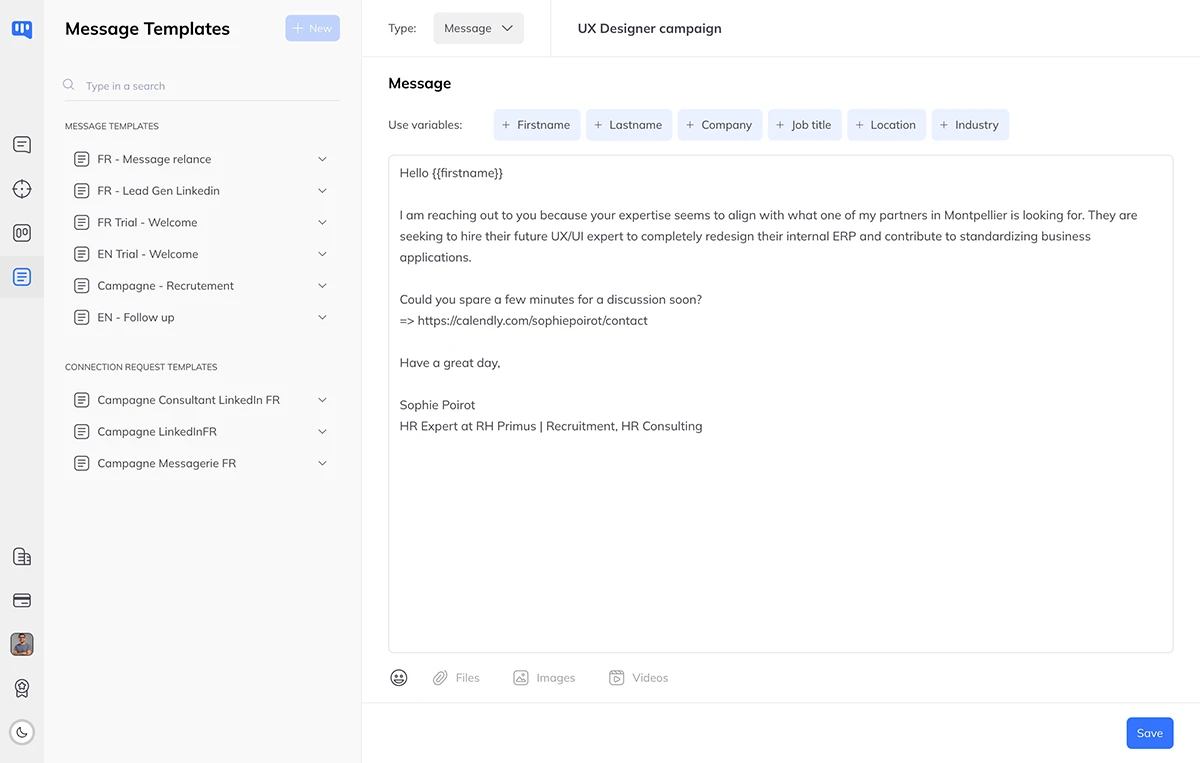
These templates let you generate generic messages that can be customized with each candidate's information:
- Firstname
- Lastname
- Company name
- Job title
- Location
- Industry
These details are automatically added to the message at the time of sending.
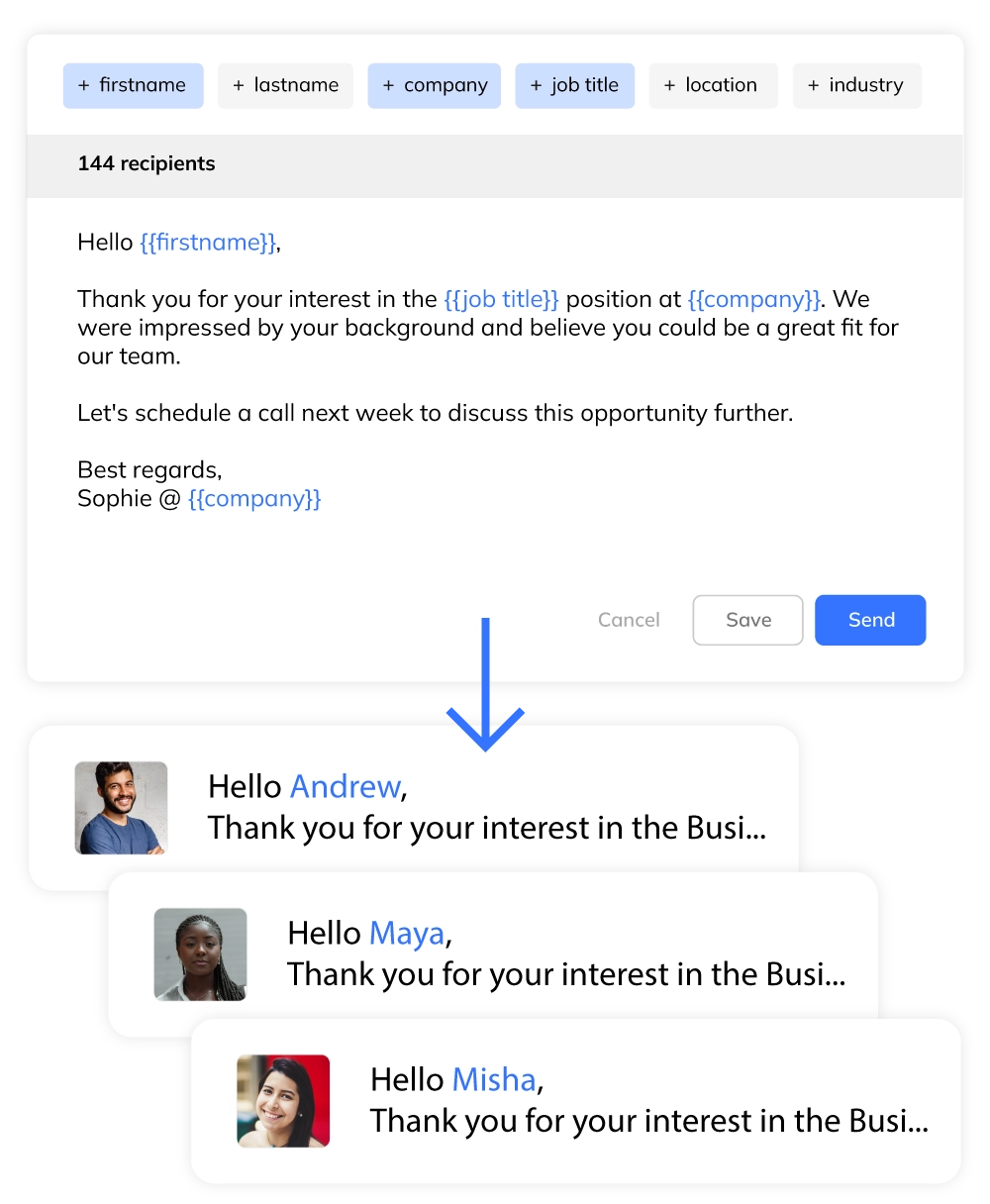
This allows you to send a message to multiple members in a single action. You can create as many message templates as needed for different situations, such as :
- contacting interesting candidates
- informing rejected candidates
- scheduling a meeting
- and more
This not only saves time but also ensures your messages are more relevant and personalized for each recipient.
Automate Your Candidate Prospecting with Kanbox!
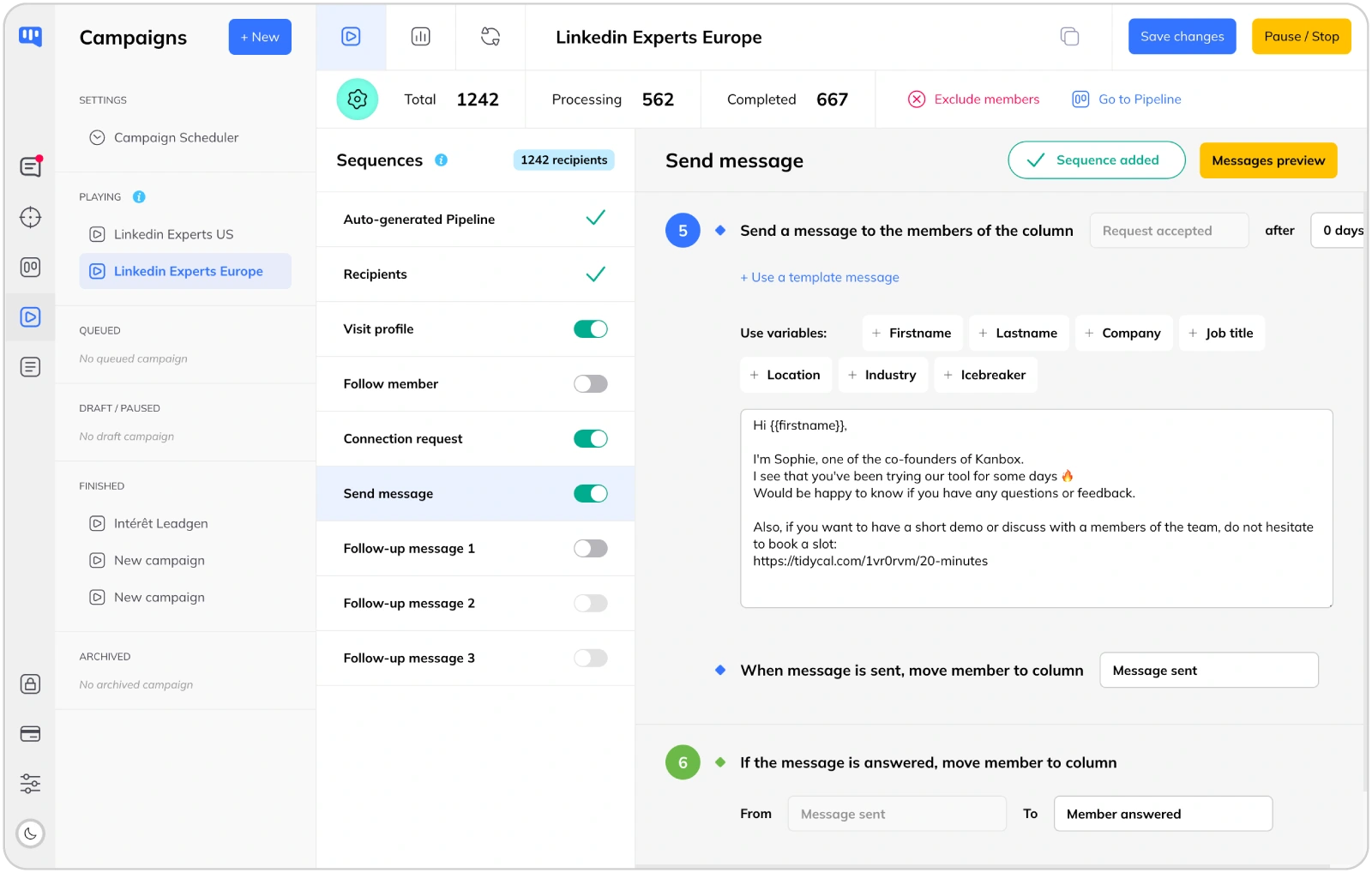
Kanbox allows you to automate your prospecting campaigns with action sequences that you can launch on your various candidate lists:
- Profile visit
- Connection request
- Message sending
- Follow-up #1
- Follow-up #2
- Follow-up #3

Track Your Recruitment Campaigns in Real-Time with Kanbox
Each campaign automatically creates a Kanban board, and as your campaign sequences progress, candidates move automatically from one column to another.
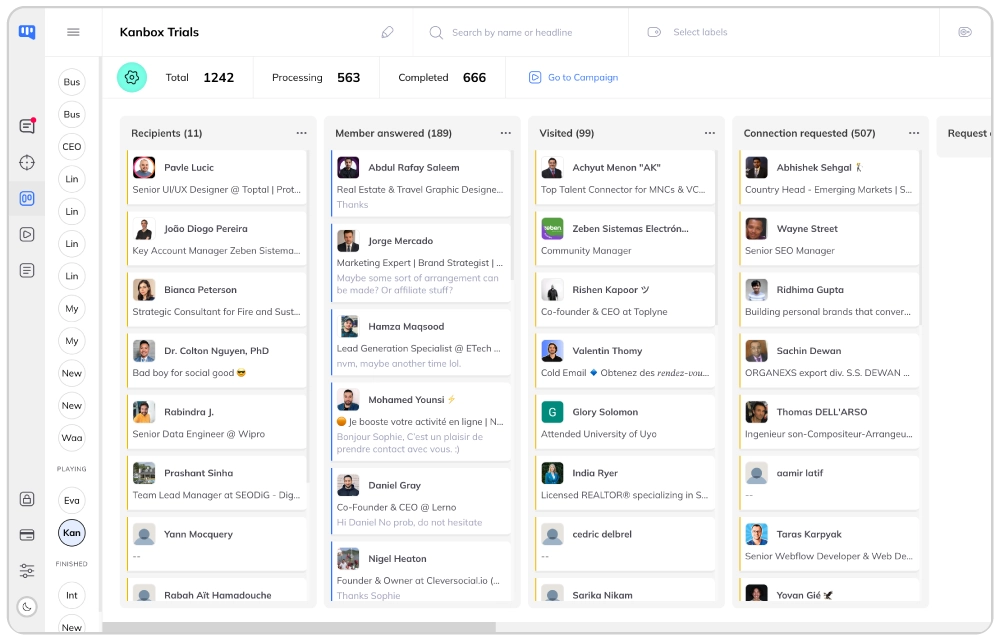
Campaign Statistics to Master Your Prospecting
Campaign statistics allow you to monitor the progress of your campaigns with complete transparency.

At this point, you might be wondering: how can you use Kanbox for automated campaigns if you can't extract data from LinkedIn? Is it possible to extract candidate lists from LinkedIn?
You can't.
Well, you can if you subscribe to a very expensive LinkedIn Enterprise plan.
The alternative is to use a third-party tool. But here again, Kanbox does the job very well.
Export candidates from Linkedin to Kanbox
Whether you're using the free version or the paid Sales Navigator version, Kanbox allows you to easily extract profiles and lists of candidates.
The Kanbox member export module
This module allows you to export Linkedin members to Kanbox by visiting their profile page.
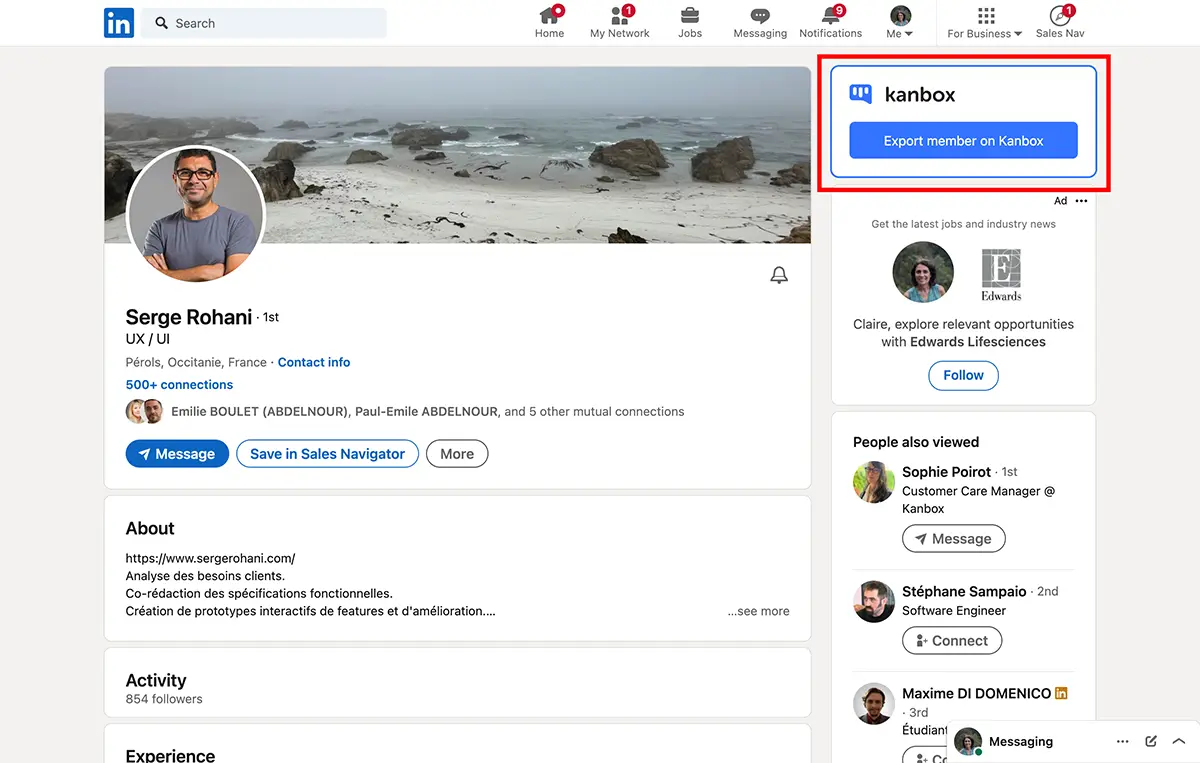
Export multiple candidates at once
Go to the Linkedin search, enter a search query, and click on the "People" tab. Give a name to the candidate list you're about to export, then click the "Export to Kanbox" button.
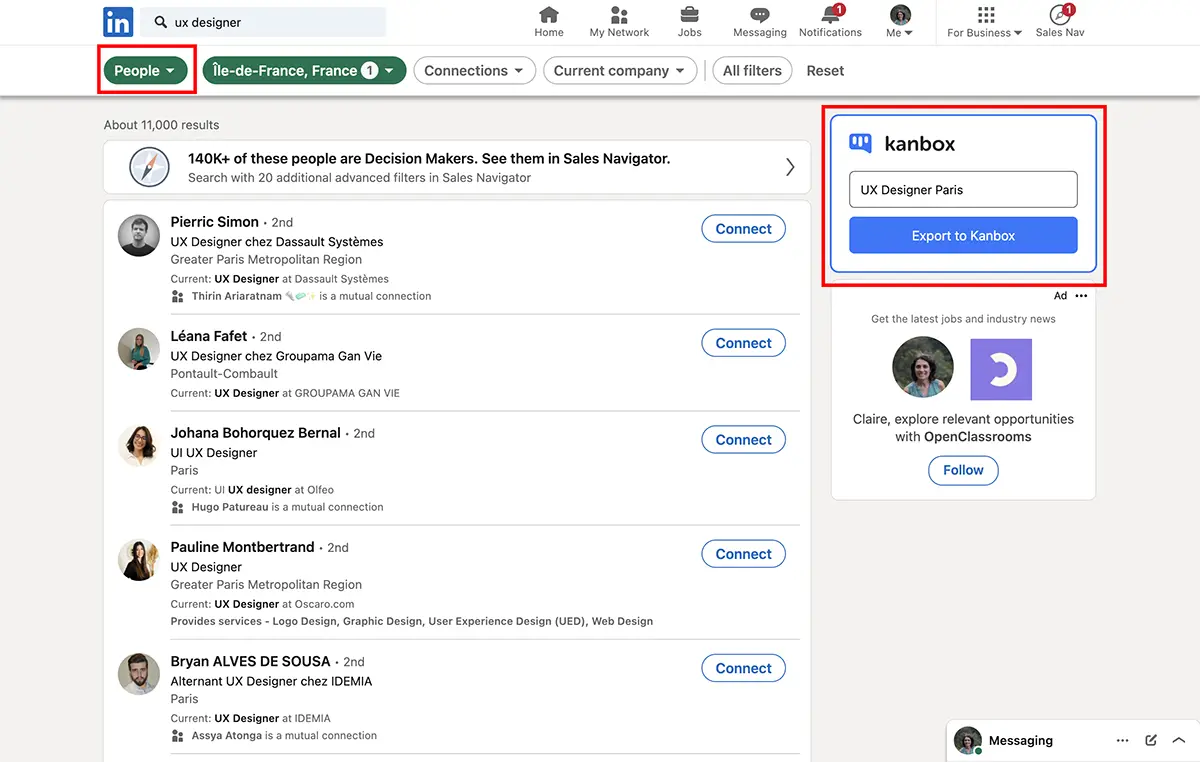
Exporting Linkedin Sales Navigator candidate lists to Kanbox
Exporting candidates from Linkedin Sales Navigator is almost identical. Go to the Leads search, add your filters, and on the Kanbox export module, enter a name for your list and click the export button.
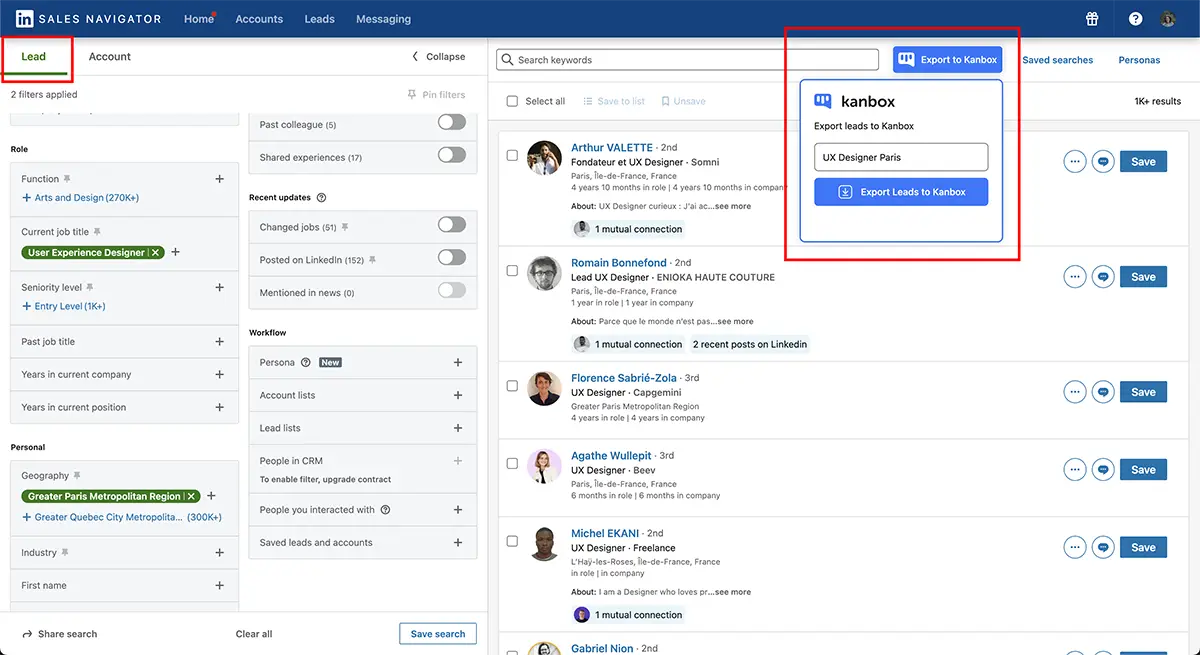
Kanbox also lets you export candidates from your saved searches.
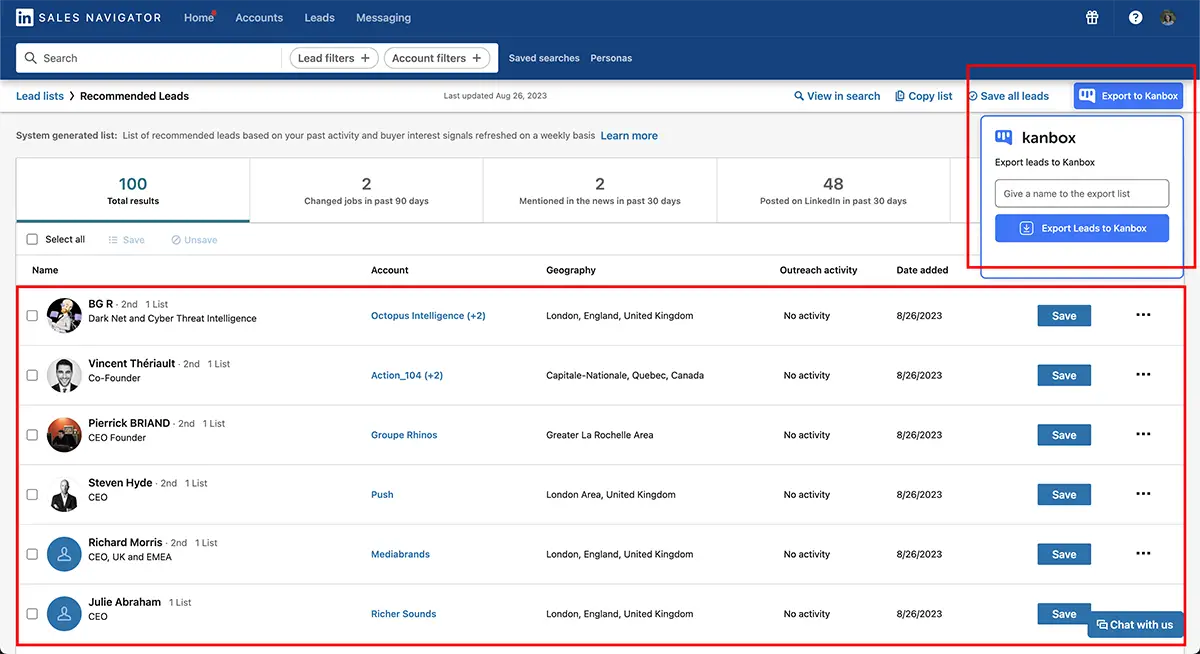
Consult our comprehensive article How to Use Sales Navigator to learn how to utilize advanced filters and identify the best candidates.
Locate exported candidates on Kanbox
All members exported from LinkedIn go to the Leads section of Kanbox.
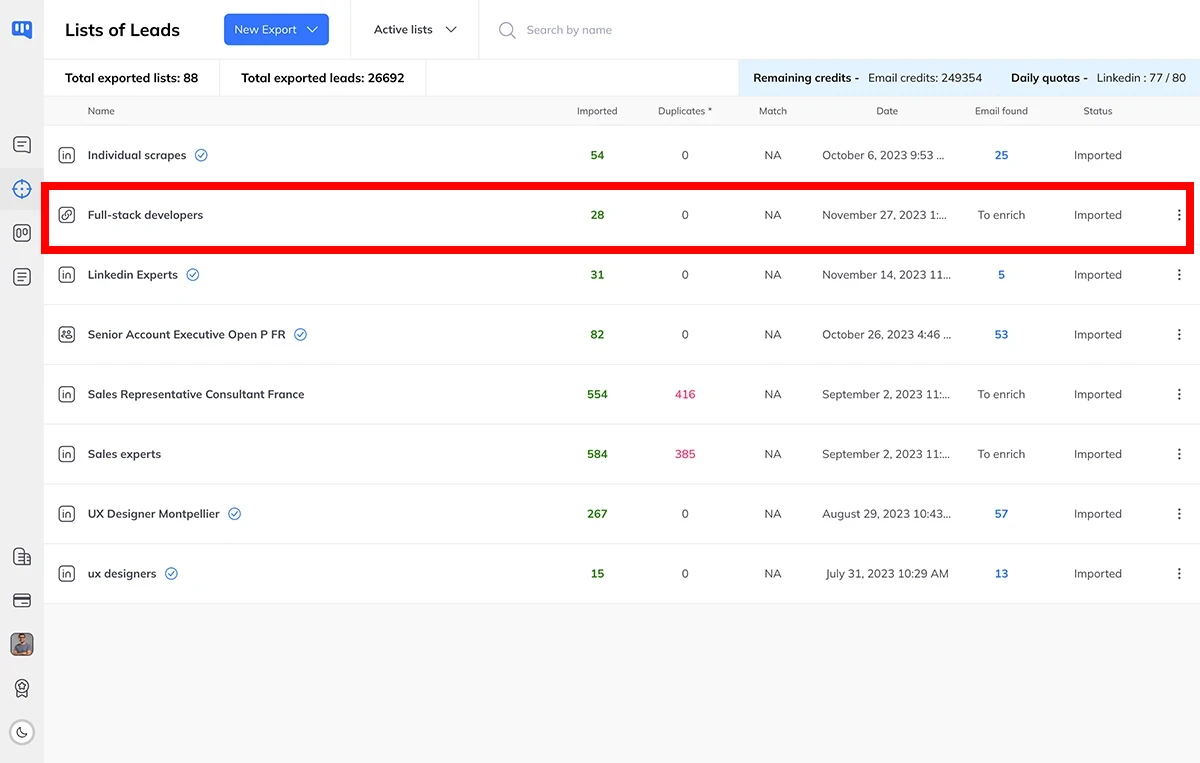
Click on one of the lists and access the candidates you've exported.
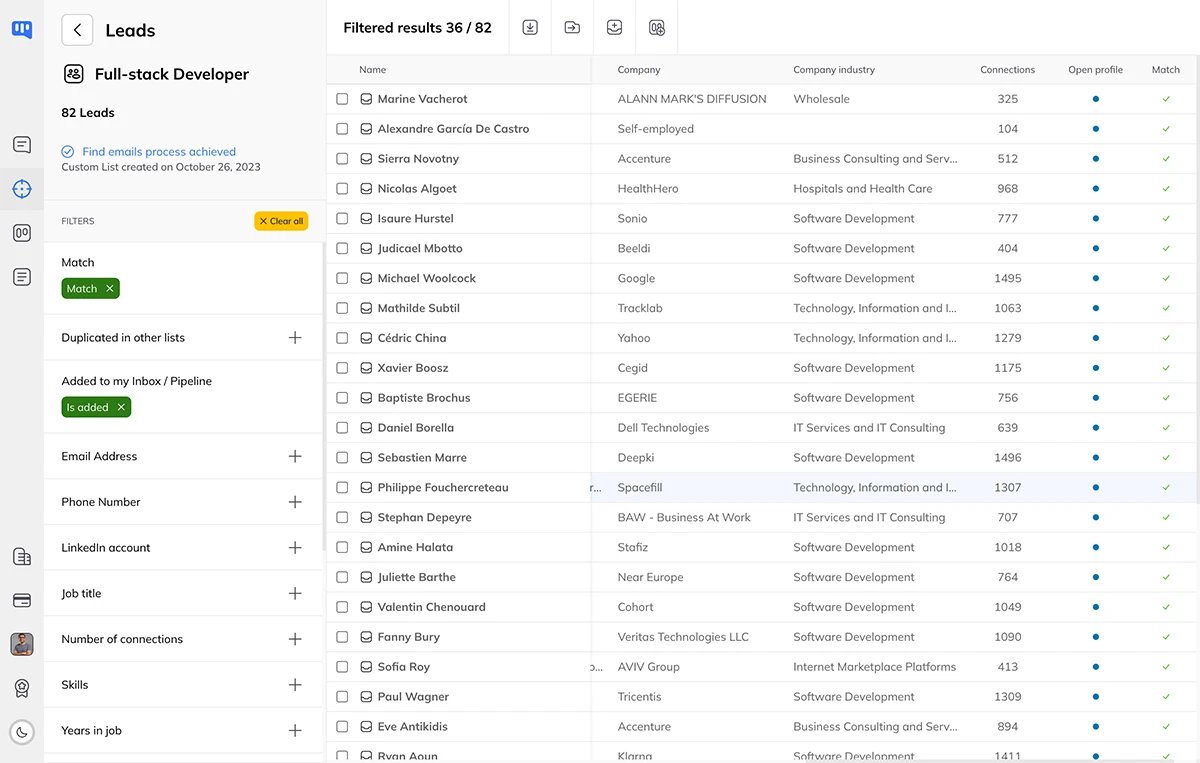
You can refine your list using Kanbox advanced filters, create custom lists, export it in CSV, and find missing email addresses of candidates.
Once you have meticulously prepared a candidate list, go back to the "Automations" section of Kanbox, then create a new campaign and select your list in the "Recipients" section. Next, activate the sequences you want to execute on your candidate list.
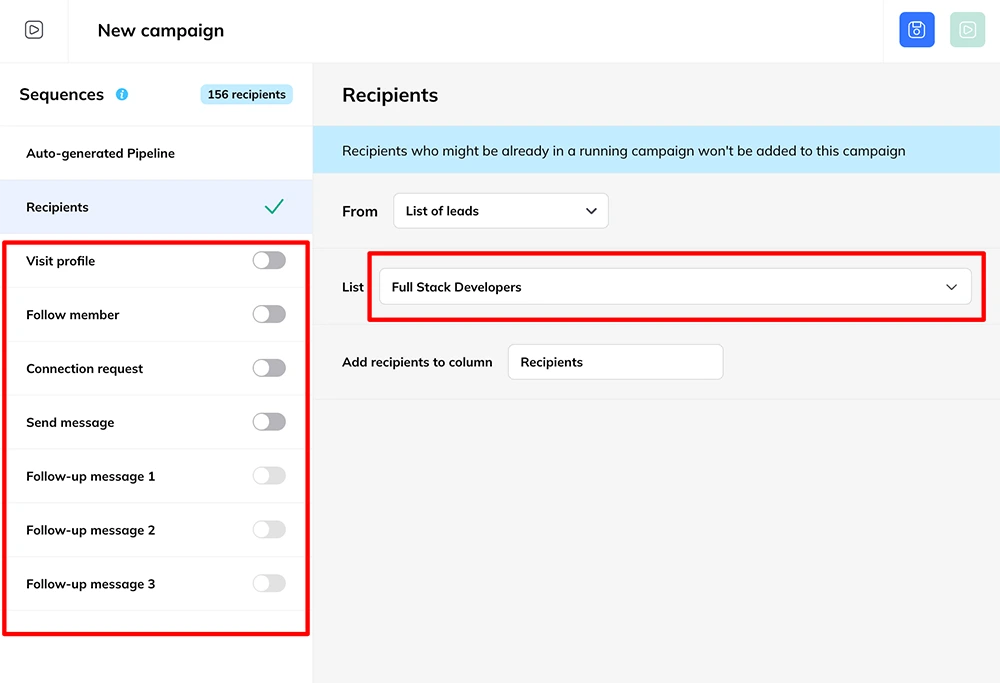
It's your turn!
Linkedin offers an invaluable talent pool, but as you've seen, successful recruitment requires more than merely posting job ads. These 7 tips, from creating your company page to utilizing advanced tools, will help you discover top talent and successfully strengthen your team.

